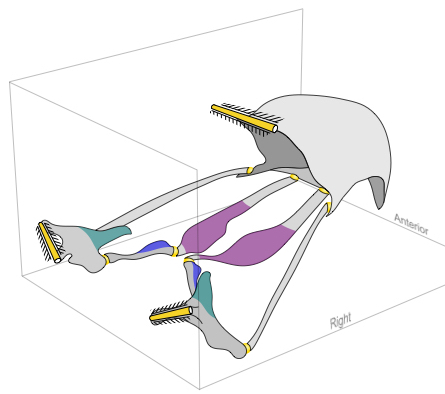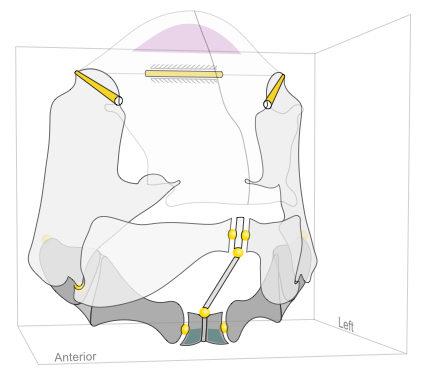Modeling musculoskeletal systems as mechanical linkages
Mechanical linkages, interconnected chains of rigid links, provide a useful
model for the motion and force transmission of musculoskeletal systems,
particularly for those systems in which the skeletal elements interconnect
to form closed chains (or loops). Mechanical linkages have been
used as models for a diversity of musculoskeletal systems, including the skulls of
fishes (
Westneat 1990)
, some lizards (
Metzger 2002),
and birds (
Van Gennip and Berkhoudt 1992),
the rib cages of birds (
Claessens 2009),
and the striking appendages of mantis shrimps (
Patek et al. 2007).
However, previous applications of linkage modeling have predominately focused
on 2D models and linkages in which all the links
interconnect as a single chain, excluding a number of diverse musculoskeletal
characterized by 3D motions and elements that interconnect
to form multiple, nested chains (referred to in engineering as multiloop or
parallel linkages).
Working with Mark Westneat (University of Chicago), I have developed new 3D,
parallel linkage models for cranial kinesis in the skulls of birds and fishes
(
Olsen and Westneat 2016).
To perform linkage model simulations I have developed a new software package for the R language,
linkR.
Together with
StereoMorph
and
svgViewR,
this provides an entirely free and open-source workflow for
3D shape data collection, general kinematic simulation of 2D and 3D linkages,
and 3D animated visualizations.
I am currently working with Beth Brainerd (Brown University) and Ariel Camp (Brown University)
to test 2D and 3D 4-bar linkage models against the
in vivo kinematics
of the lower jaw-opercular mechanism in largemouth bass.
And as a part of my postdoctoral research I will be testing 3D, parallel
linkage models against
in vivo cranial kinematics in several species
of primarily suction-feeding fishes. I will then apply these models to a diverse
sampling of shape data from natural history collections to examine how cranial
mobility and suction performance differ across different orders of fishes.
Publications resulting from this project
Olsen AM*, Camp AL* & Brainerd EL (2017). The opercular mouth-opening mechanism of largemouth bass functions as a 3D four-bar linkage with three degrees of freedom. Journal of Experimental Biology. 220:4612-4623. DOI: 10.1242/jeb.159079. Get via JEB, via ResearchGate.*Equal author contributions
Olsen AM, Westneat MW (2016). Linkage mechanisms in
the vertebrate skull: Structure and function of three-dimensional, parallel transmission systems.
Journal of Morphology. Early View. DOI: 10.1002/jmor.20596.
Get via Wiley;
Get via ResearchGate.
Olsen AM, Westneat MW (2015). StereoMorph: an R package for the collection of 3D landmarks and curves using a stereo camera setup. Methods in Ecology and Evolution. 6:351-356. DOI: 10.1111/2041-210X.12326. Get via Wiley (open access).
Software related to this project


